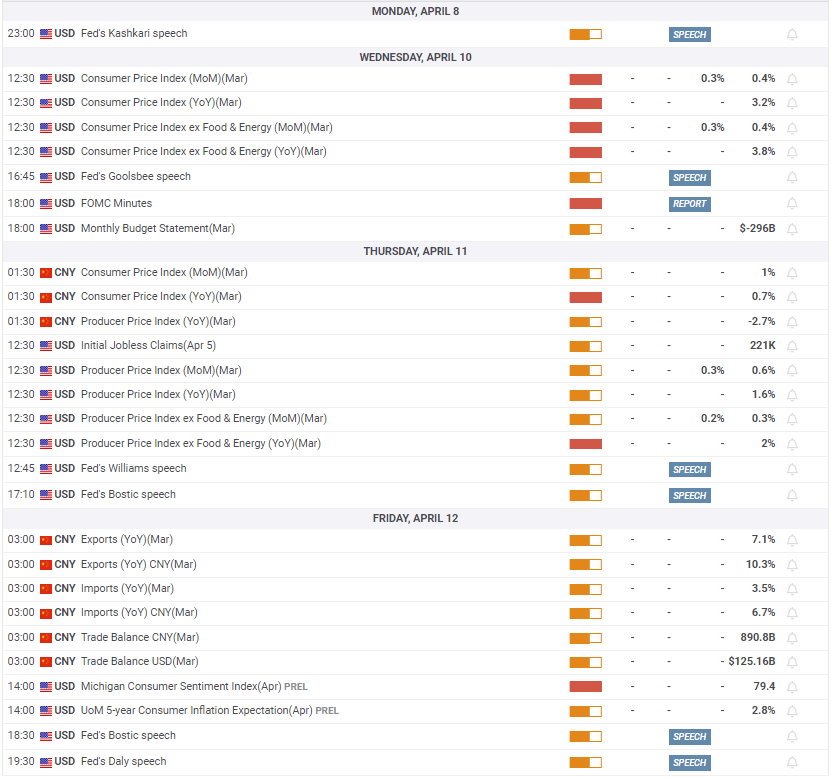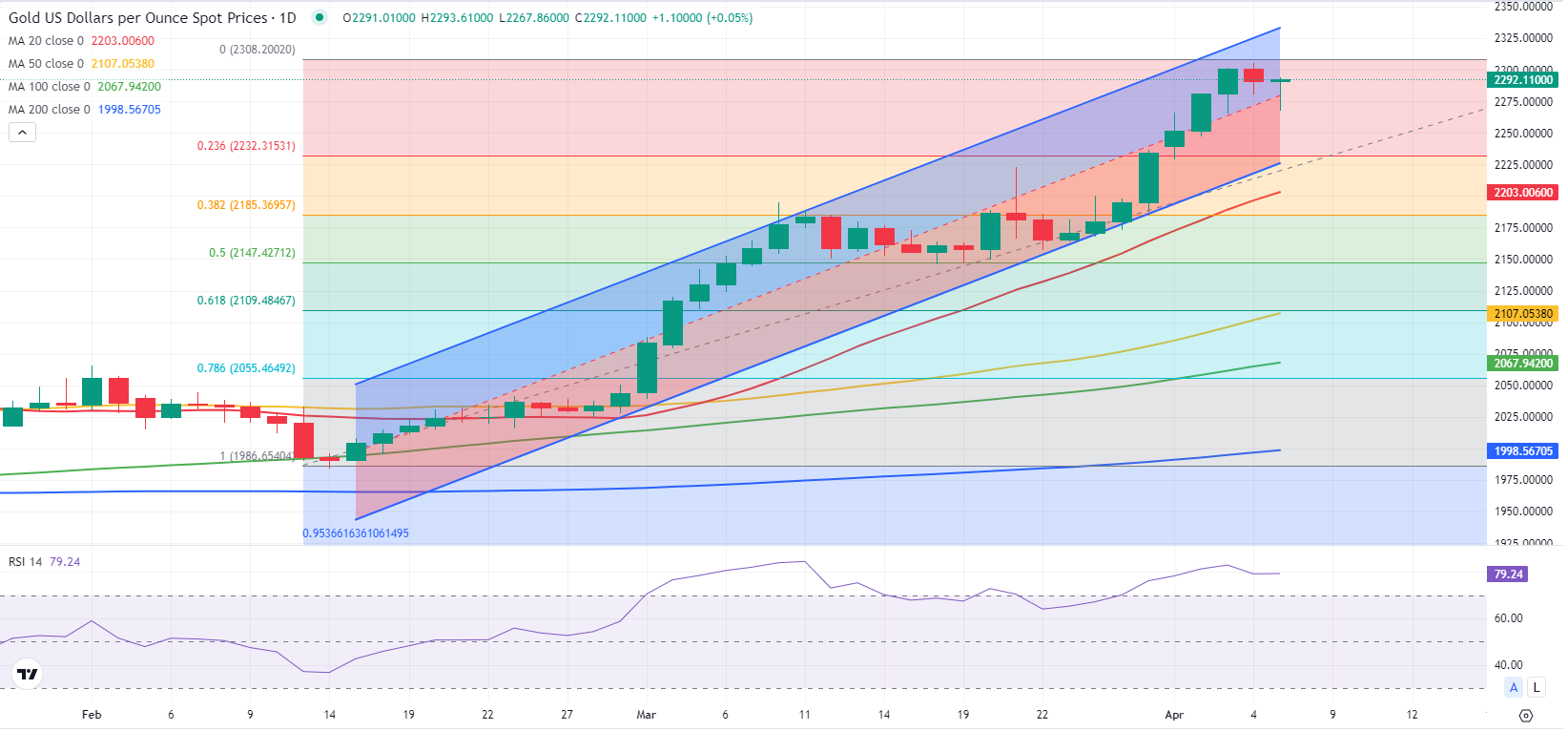- Gold price reached a new record high above $2,300 this week.
- XAU/USD remains technically overbought despite the latest pullback.
- US inflation data next week could significantly impact Gold’s valuation.
Gold price (XAU/USD) preserved its bullish momentum and registered strong gains in the first three days of the week. Following a short-lasting correction on Thursday, the pair regained its traction and touched a new record high above $2,300 on Friday. Next week’s inflation data from the US could significantly influence the market pricing of the Federal Reserve’s (Fed) interest rate outlook and drive Gold’s valuation.
Gold rally picked up steam this week
Gold gained traction at the weekly opening as trading conditions started to normalize following the long weekend. With investors reacting to the slightly softer-than-forecast Personal Consumption Expenditures (PCE) Price Index data that was released on Easter Friday, the US Dollar (USD) struggled to find demand on Monday and allowed XAU/USD to push higher. Later in the American session, the USD staged a rebound following the upbeat ISM Manufacturing PMI and limited Gold’s upside.
In the absence of high-tier data releases, Gold extended its rally on Tuesday and gained over 1% on a daily basis. On Wednesday, the data from the US showed that the ISM Services PMI edged lower to 51.4 in March from 52.6 in February. More importantly, the Prices Paid Index, the inflation component of the survey, declined to 53.4 from 58.6, highlighting a softening in the service sector’s input inflation. As the USD came under renewed selling pressure after this report, XAU/USD closed the seventh consecutive day in positive territory.
Gold continued to climb higher in the Asian session on Thursday and set a new all-time high of $2,305 before staging a technical correction and snapping its winning streak. Hawkish comments from Fed officials helped the USD stay resilient against its rivals and caused XAU/USD to reverse its direction in the second half of the day. Minneapolis Fed President Neel Kashkari noted that he projected two rate reductions in 2024 but said that now he wonders if the Fed should cut rates at all this year if inflation continues to move sideways. Moreover, Richmond Fed President Thomas Barkin noted that it's "hard to reconcile current breadth of inflation with the progress the Fed needs to see for rate cuts."
The US Bureau of Labor Statistics (BLS) announced on Friday that Nonfarm Payrolls rose 303,000 in March. This reading followed the 270,000 increase (revised from 275,000) recorded in February and surpassed the market expectation of 200,000 by a wide margin. Other details of the jobs report showed that the Unemployment Rate edged lower to 3.8% from 3.9% in February while the annual wage inflation, as measured by the change in the Average Hourly Earnings, softened to 4.1% from 4.3% as projected. The USD held its ground after the upbeat labor market data but Gold ignored the USD strength and advanced beyond $2,310.
Throughout this week, Gold’s usual inverse correlation with US Treasury bond yields weakened. Although the benchmark 10-year US Treasury bond yield climbed above 4.4% for the first time since November, Gold continued to stretch higher as it benefited from escalating geopolitical tensions.
Iran pledged to retaliate against Israel after seven officers got killed in a suspected Israeli airstrike on the Iranian embassy compound in Syria earlier in the week, reviving fears over a deepening and prolonged conflict in the Middle East. Additionally, there is market speculation about China unloading US Treasury bond holdings to replace them with Gold. This could be a possible explanation for how Gold continued to gain value while US T-bond yields edged higher but it’s difficult to confirm or deny this theory due to a lack of available information. Chinese central bank does announce changes in its reserves but this data will be available around mid-May. World Gold Council reported on March 13 that the People’s Bank of China (PBoC) announced that Gold reserves had increased by 22 tonnes in February.
Gold investors await US inflation data, watch geopolitics
The US economic docket will not offer any high-tier data releases at the beginning of next week. On Wednesday, the BLS will publish the Consumer Price Index (CPI) data for March. On a monthly basis, the CPI and the core CPI are both forecast to rise 0.3%. In case the monthly core CPI rises at a stronger pace than forecast, the immediate reaction could boost the USD and trigger a downward correction in Gold. On the other hand, a print of 0.2% or lower could revive expectations for a June rate cut and hurt the USD.
The BLS will release the Producer Price Index (PPI) data on Thursday. In the past, market participants paid little to no mind to producer inflation data. The previous couple of PPI releases, however, triggered big reactions. In February, the PPI rose 0.6% on a monthly basis. A similarly strong growth in monthly producer inflation could feed into expectations about consumer inflation remaining sticky and support the USD.
On Thursday, the European Central Bank (ECB) will announce its monetary policy decisions. This event might not have a direct impact on Gold’s valuation. However, a dovish ECB stance could highlight the policy divergence between the Fed and drive capital outflows out of the Euro into the USD. In this scenario, the broad-based USD strength could make it difficult for XAU/USD to gain traction.
In the Asian session on Friday, Trade Balance data from China, the world’s biggest consumer of Gold, will be watched closely by market participants. If this data points to an improving economic growth outlook in China, Gold could benefit from it.
Investors will also keep a close eye on geopolitical developments and comments from Fed officials. A further escalation of tensions in the Middle East could support XAU/USD regardless of the USD’s overall performance.
Gold technical outlook
The Relative Strength Index (RSI) indicator on the daily chart stays well above 70, suggesting that Gold remains technically overbought in the near term. If XAU/USD fails to reach a new high and starts a technical correction, the Fibonacci 23.6% retracement of the February-April uptrend could be seen as the first bearish target at $2,230 ahead of $2,200 (20-day Simple Moving Average).
It’s difficult to set bullish targets for Gold but buyers could remain interested as long as holds steady above $2,300. The upper limit of the ascending regression channel could act as resistance at $2,330.
Inflation FAQs
Inflation measures the rise in the price of a representative basket of goods and services. Headline inflation is usually expressed as a percentage change on a month-on-month (MoM) and year-on-year (YoY) basis. Core inflation excludes more volatile elements such as food and fuel which can fluctuate because of geopolitical and seasonal factors. Core inflation is the figure economists focus on and is the level targeted by central banks, which are mandated to keep inflation at a manageable level, usually around 2%.
The Consumer Price Index (CPI) measures the change in prices of a basket of goods and services over a period of time. It is usually expressed as a percentage change on a month-on-month (MoM) and year-on-year (YoY) basis. Core CPI is the figure targeted by central banks as it excludes volatile food and fuel inputs. When Core CPI rises above 2% it usually results in higher interest rates and vice versa when it falls below 2%. Since higher interest rates are positive for a currency, higher inflation usually results in a stronger currency. The opposite is true when inflation falls.
Although it may seem counter-intuitive, high inflation in a country pushes up the value of its currency and vice versa for lower inflation. This is because the central bank will normally raise interest rates to combat the higher inflation, which attract more global capital inflows from investors looking for a lucrative place to park their money.
Formerly, Gold was the asset investors turned to in times of high inflation because it preserved its value, and whilst investors will often still buy Gold for its safe-haven properties in times of extreme market turmoil, this is not the case most of the time. This is because when inflation is high, central banks will put up interest rates to combat it. Higher interest rates are negative for Gold because they increase the opportunity-cost of holding Gold vis-a-vis an interest-bearing asset or placing the money in a cash deposit account. On the flipside, lower inflation tends to be positive for Gold as it brings interest rates down, making the bright metal a more viable investment alternative.
Information on these pages contains forward-looking statements that involve risks and uncertainties. Markets and instruments profiled on this page are for informational purposes only and should not in any way come across as a recommendation to buy or sell in these assets. You should do your own thorough research before making any investment decisions. FXStreet does not in any way guarantee that this information is free from mistakes, errors, or material misstatements. It also does not guarantee that this information is of a timely nature. Investing in Open Markets involves a great deal of risk, including the loss of all or a portion of your investment, as well as emotional distress. All risks, losses and costs associated with investing, including total loss of principal, are your responsibility. The views and opinions expressed in this article are those of the authors and do not necessarily reflect the official policy or position of FXStreet nor its advertisers. The author will not be held responsible for information that is found at the end of links posted on this page.
If not otherwise explicitly mentioned in the body of the article, at the time of writing, the author has no position in any stock mentioned in this article and no business relationship with any company mentioned. The author has not received compensation for writing this article, other than from FXStreet.
FXStreet and the author do not provide personalized recommendations. The author makes no representations as to the accuracy, completeness, or suitability of this information. FXStreet and the author will not be liable for any errors, omissions or any losses, injuries or damages arising from this information and its display or use. Errors and omissions excepted.
The author and FXStreet are not registered investment advisors and nothing in this article is intended to be investment advice.
Recommended Content
Editors’ Picks

Gold gives away some gains, slips back to $2,980
Gold retraced from its earlier all-time highs above the key $3,000 mark on Friday, finding a footing around $2,980 per troy ounce. Profit-taking, rising US yields, and a shift to a risk-on environment seem to be putting the brakes on further gains for the metal.

EUR/USD remains firm and near the 1.0900 barrier
EUR/USD is finding its footing and trading comfortably in positive territory as the week wraps up, shaking off two consecutive daily pullbacks and setting its sights back on the pivotal 1.0900 mark—and beyond.

GBP/USD remains depressed, treads water in the low-1.2900s
GBP/USD is holding steady in consolidation territory after Friday’s opening bell on Wall Street, hovering in the low-1.2900 range. This resilience comes despite disappointing UK data and persistent selling pressure on the USD.

Crypto Today: BNB, OKB, BGB tokens rally as BTC, Shiba Inu and Chainlink lead market rebound
Cryptocurrencies sector rose by 0.13% in early European trading on Friday, adding $352 million in aggregate valuation. With BNB, OKB and BGB attracting demand amid intense market volatility, the exchange-based native tokens sector added $1.9 billion.

Week ahead – Central banks in focus amid trade war turmoil
Fed decides on policy amid recession fears. Yen traders lock gaze on BoJ for hike signals. SNB seen cutting interest rates by another 25bps. BoE to stand pat after February’s dovish cut.

The Best brokers to trade EUR/USD
SPONSORED Discover the top brokers for trading EUR/USD in 2025. Our list features brokers with competitive spreads, fast execution, and powerful platforms. Whether you're a beginner or an expert, find the right partner to navigate the dynamic Forex market.

